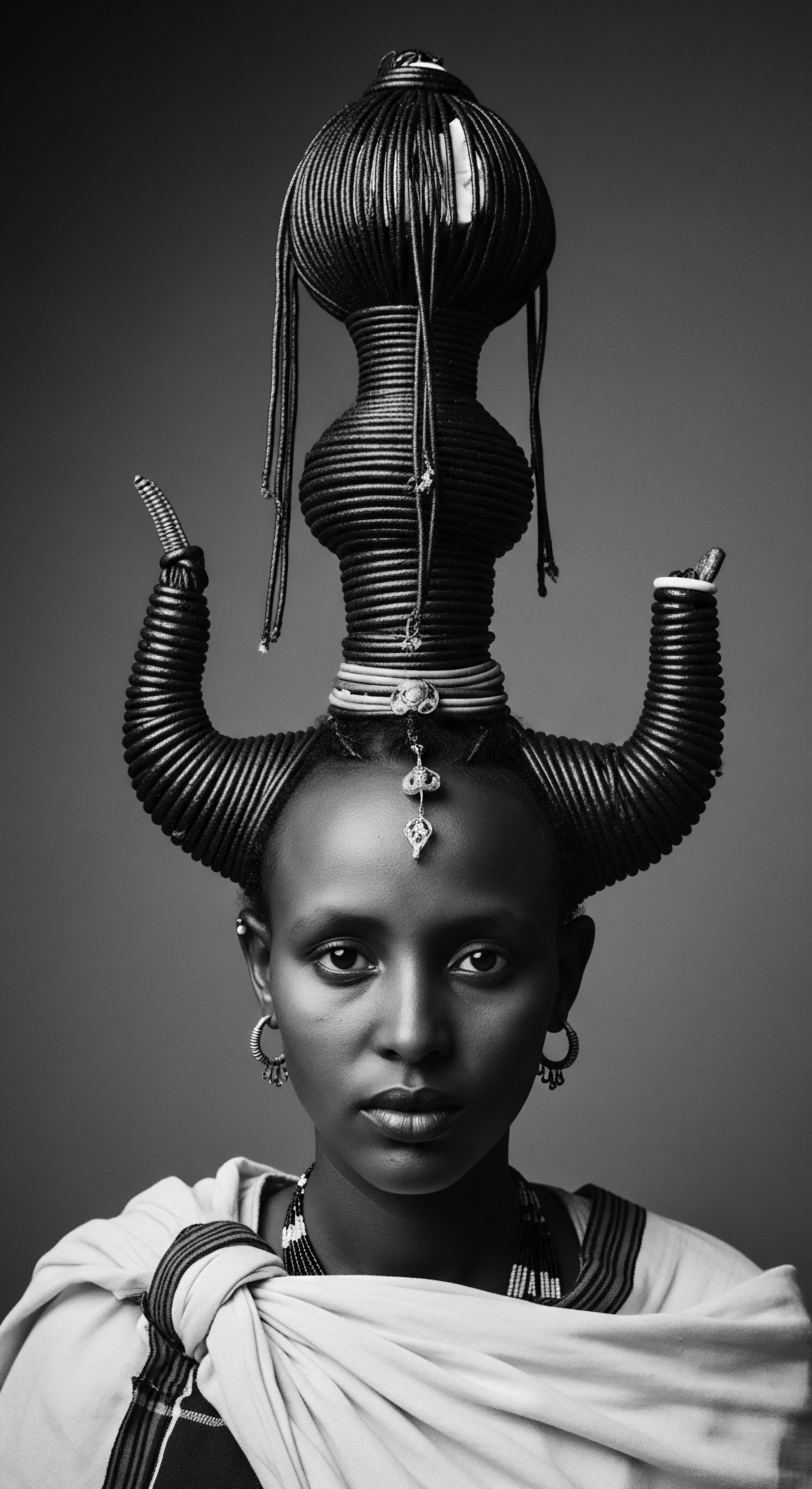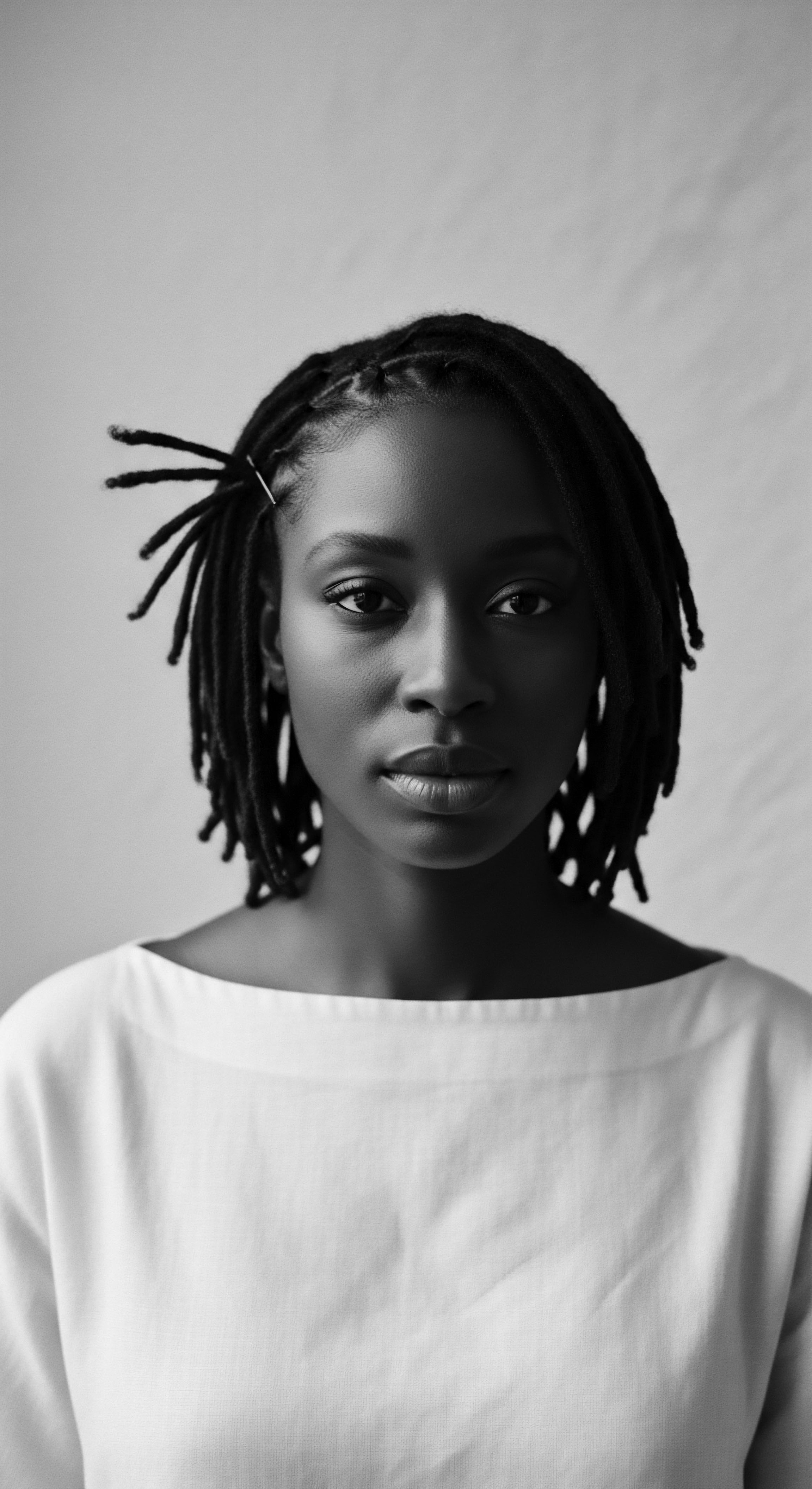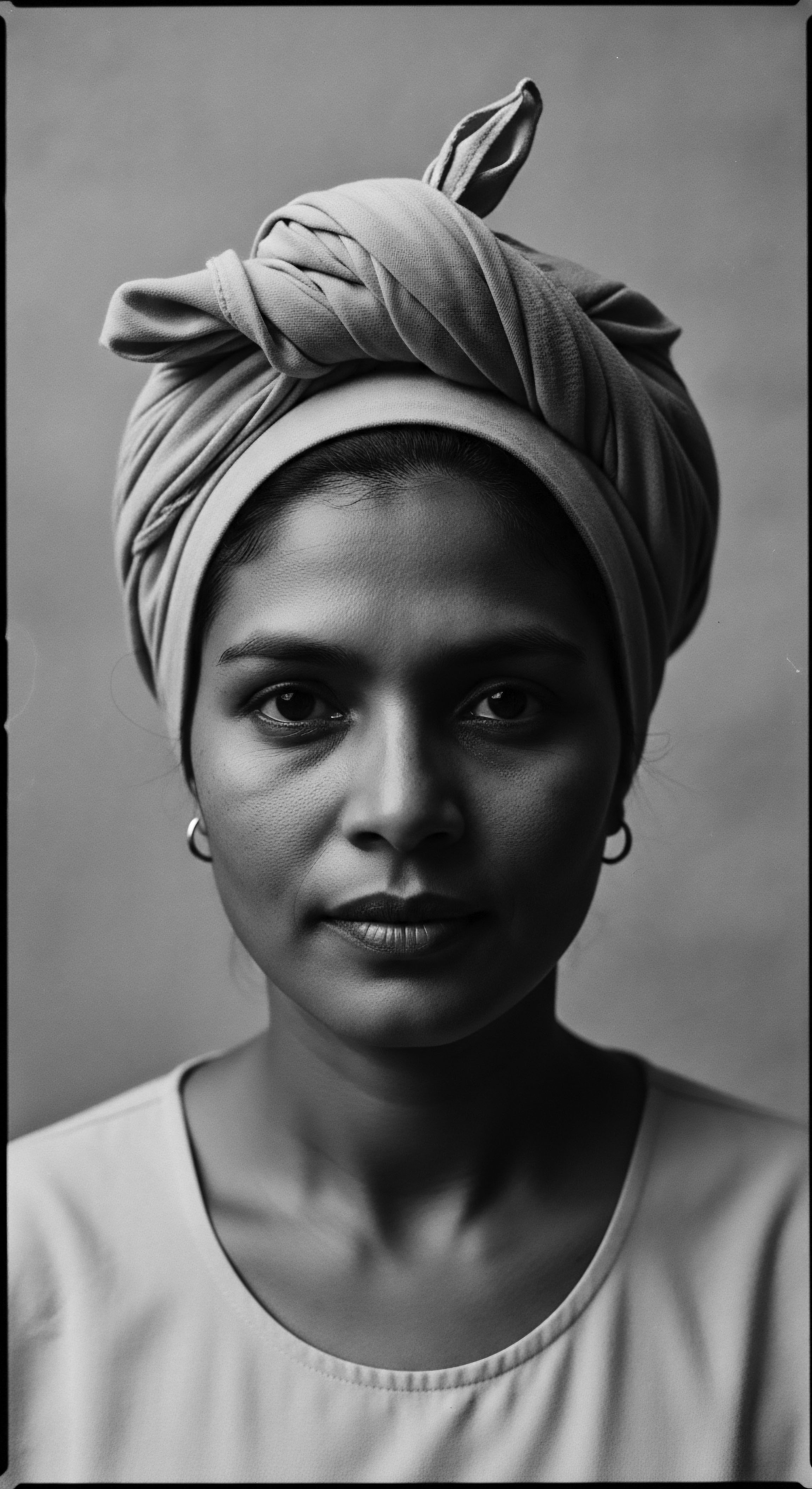
Fundamentals
The concept of Online Archiving, at its most elemental, refers to the deliberate act of collecting, preserving, and making accessible information and artifacts within digital spaces. This process transcends the mere storage of data; it encompasses the thoughtful organization and classification of digital materials, ensuring their longevity and discoverability for those who seek to understand their lineage. When we speak of this practice in the context of textured hair heritage, its significance deepens considerably, becoming a vital current for safeguarding ancestral knowledge and the living legacy of Black and mixed-race hair traditions. It represents a conscious decision to give permanency to what might otherwise fade, securing a vibrant digital space for stories passed through generations.
Consider the myriad forms that hair heritage assumes ❉ ancient braiding patterns passed through generations, the wisdom of natural remedies, the social narratives woven into every coil and kink, and the visual chronicles of styles that have shaped identity across diasporas. Historically, these invaluable aspects of hair culture resided within oral traditions, in the hands of skilled practitioners, or nestled within family albums. Each whispered instruction for a hair regimen, every shared secret of a resilient scalp, every faded photograph of a matriarch’s crown represented a living, breathing archive, held in the collective memory of a community. The digital realm now extends this inherent human drive to preserve, offering new avenues to secure these precious fragments of identity, allowing them to transcend geographical boundaries and time.
Online Archiving, for textured hair heritage, transforms fleeting moments and whispered wisdom into enduring digital legacies, ensuring ancestral knowledge remains vibrant and accessible.

Echoes from the Source ❉ Hair as the Original Archive
Before the advent of digital technology, the very strands on our heads held ancestral echoes. Hair, in its biological composition, carries traces of diet, environment, and even stress, serving as a silent, physical record of one’s personal journey. Pigments within the hair follicle can hint at lineage, while structural patterns reflect inherited traits. In many ancestral societies, hair was a powerful symbol, a spiritual conduit, and a marker of status, age, or tribal affiliation.
The intricate designs etched into hair, the careful selection of ingredients for cleansing and conditioning, and the communal rituals surrounding hair care were not random acts; they were intentional expressions of identity and custodians of shared history. These practices formed a living, human-based archiving system, where knowledge was embodied and transmitted directly through touch, observation, and shared experience.
The transition to a digital medium represents a natural progression of this deep-seated human desire to remember and to teach. Online Archiving allows us to capture the ephemeral nature of oral histories and the fragility of physical artifacts, giving them a renewed, accessible existence. It creates a boundless space where the stories of our hair, from the ancient adornments of African queens to the revolutionary styles of the Civil Rights movement, can reside together, interconnected and illuminated for future generations.
This digital space serves as a communal hearth, inviting individuals to share their personal narratives, thus contributing to a larger, collective memory of textured hair that spans continents and centuries. This collective memory fosters a profound appreciation for the continuous lineage of Black and mixed-race hair expressions.

Early Forms of Digital Preservation in Hair Culture
The rudimentary beginnings of Online Archiving for hair heritage often manifest in unexpected places, born from the simple human need to connect and share. Think of the early online forums and bulletin boards where individuals exchanged tips on natural hair care, sharing recipes for conditioners or methods for detangling. These digital conversations, though informal and often fleeting, were embryonic archives, capturing a specific moment in the nascent resurgence of natural hair movements. Such discussions offered a space for collective learning and mutual support, bypassing mainstream beauty narratives.
Similarly, the uploading of personal photographs to nascent social media platforms, documenting hair transformations or celebratory styles, constituted a spontaneous act of preservation. Each image, each comment, each shared video clip contributes to a sprawling, decentralized chronicle of hair experiences, driven by the individual desire to connect and affirm identity. These personal contributions, often uploaded without formal metadata or long-term preservation in mind, collectively paint a vivid picture of evolving hair aesthetics and practices. They capture the joy, the experimentation, and the communal pride associated with textured hair journeys.
These early digital spaces, while perhaps not conforming to formal archival standards, established a precedent for community-driven documentation. They underscored the intrinsic value placed on textured hair knowledge within its own communities, often in contrast to dominant beauty standards that historically sought to diminish or erase it. By offering platforms for self-representation, these digital spaces became sanctuaries where ancestral practices could be openly discussed, celebrated, and innovated upon, ensuring their continued presence in the contemporary world. This communal digital stewardship underscores the deeply personal and profoundly public nature of hair as an identity marker, demonstrating that even informal digital acts hold significant cultural weight.

Intermediate
Moving beyond basic definitions, Online Archiving at an intermediate level involves a more deliberate consideration of content management, metadata, and the strategic design of digital repositories. Here, the emphasis shifts from merely saving information to organizing it in a manner that ensures its authenticity, integrity, and long-term accessibility. For the unique world of textured hair heritage, this means developing frameworks capable of capturing the richness of its history—from the scientific composition of various hair textures to the cultural rituals surrounding their care and adornment across diverse Afro-diasporic communities. This methodical approach ensures that the digital legacy is not only extensive but also genuinely useful for research and cultural continuity.

The Tender Thread ❉ Weaving Digital Structure and Context
The act of Online Archiving is akin to weaving a complex fabric, where each thread represents a piece of information, meticulously placed to form a cohesive whole. This process involves the creation of Metadata, which acts as descriptive data about the archived content. For a photograph of a historical braided style, metadata would include the date, location, the name of the individual (if known), the type of braid, and its cultural significance.
This systematic labeling permits researchers, community members, and future generations to accurately contextualize and retrieve specific information, transforming scattered digital assets into a searchable, meaningful collection. Proper metadata ensures that the spirit and context of the hair practices are conveyed alongside the visual or textual information.
Understanding the implications of digital rights and ownership becomes paramount at this stage. Many traditional hair practices and designs are community intellectual property, passed down through generations. Online Archiving must navigate these ethical considerations with care, ensuring that the digital representation honors the originators and communities, avoiding appropriation or misrepresentation.
The goal is to facilitate access and learning while safeguarding the cultural integrity of the heritage being preserved. This delicate balance requires thoughtful engagement with the communities whose stories and practices are being archived, emphasizing collaboration and respect for their ancestral knowledge systems.
Digital archiving for hair heritage requires not just technical precision but also a deep ethical consideration for community ownership and the cultural integrity of inherited practices.

Platforms as Custodians of Collective Memory
Various platforms serve as conduits for Online Archiving, each with distinct capabilities and limitations. Institutional archives, libraries, and museums are increasingly digitizing their collections, making historical documents, photographs, and even material culture related to hair accessible online. These formal repositories provide structured environments for long-term preservation.
Alongside these formal entities, community-led initiatives and individual creators on social media platforms also contribute significantly to this evolving digital landscape. The distributed nature of this archiving means that while some collections are highly structured, others arise organically from the collective efforts of users sharing their experiences, creating a multifaceted historical record.
Consider the vast, informal ‘archive’ of natural hair journeys and styling tutorials found on platforms like YouTube and Instagram. While not formally curated by traditional archival institutions, these platforms contain an immense volume of user-generated content that provides a living documentation of contemporary textured hair culture. Individuals share their personal routines, product discoveries, and styling techniques, often drawing directly from ancestral practices or innovating upon them.
This spontaneous collective acts as a dynamic repository, illustrating how ancestral knowledge continues to adapt and thrive in modern contexts. This form of digital sharing is a powerful, grassroots testament to resilience and creativity, reflecting the ongoing self-determination of communities to define and share their own beauty narratives.
An important aspect of this intermediate understanding involves the challenges inherent in digital preservation. Technology evolves rapidly, and digital formats can become obsolete. Ensuring the long-term viability of digital archives requires constant vigilance, including format migration, regular backups, and adherence to evolving digital preservation standards.
For hair heritage, this vigilance means safeguarding not only the images and texts but also the intangible wisdom embedded within them, ensuring that the echoes of the past remain clear and audible for all who seek them. The digital continuity of ancestral practices demands ongoing technological and ethical commitment.

Maintaining Digital Integrity of Hair Heritage
The integrity of archived digital materials about hair heritage depends on consistent maintenance and adherence to recognized standards. This includes employing robust checksums to verify data accuracy over time and ensuring files are stored in multiple, geographically dispersed locations to mitigate risks of data loss. Furthermore, the selection of appropriate file formats – such as TIFF for images or WAV for audio – contributes significantly to the longevity and accessibility of the data, as these formats are less prone to obsolescence than proprietary ones. These technical details serve the overarching goal of ensuring that the digital representations of hair knowledge remain faithful to their original forms.
| Aspect of Preservation Knowledge Transmission |
| Ancestral Practice (Pre-Digital Online Archiving) Oral storytelling, hands-on apprenticeship, family rituals around hair, communal gatherings. |
| Online Archiving (Contemporary Application) Digitized oral histories with transcripts, extensive video tutorials on techniques, global online forums for community learning, interactive webinars. |
| Aspect of Preservation Material Preservation |
| Ancestral Practice (Pre-Digital Online Archiving) Physical hair tools, adornments, family photos in albums, personal journals, ceremonial objects. |
| Online Archiving (Contemporary Application) High-resolution 2D and 3D scans of artifacts, digitized photo albums with descriptive metadata, virtual exhibitions allowing interactive viewing, digital replicas of tools. |
| Aspect of Preservation Community Access |
| Ancestral Practice (Pre-Digital Online Archiving) Limited to geographic community, direct lineage, specific gatherings, face-to-face instruction. |
| Online Archiving (Contemporary Application) Global reach, accessible via internet-enabled devices, democratized access to information that transcends physical barriers, fostering global community engagement. |
| Aspect of Preservation Contextualization |
| Ancestral Practice (Pre-Digital Online Archiving) Shared lived experience, community memory, familial stories, local cultural norms, direct mentor-protégé relationships. |
| Online Archiving (Contemporary Application) Rich metadata application, digital narratives, interconnected online resources (hyperlinks to related content), scholarly annotations, community-contributed contextual layers. |
| Aspect of Preservation Challenges Faced |
| Ancestral Practice (Pre-Digital Online Archiving) Loss due to migration, elder passing, cultural suppression, physical deterioration of artifacts. |
| Online Archiving (Contemporary Application) Technological obsolescence, digital decay, funding for long-term maintenance, issues of intellectual property rights in digital spaces, digital divide. |
| Aspect of Preservation The essence of preservation remains constant; the methods evolve, amplifying reach while honoring the roots and addressing new challenges. |

Academic
Online Archiving, at an academic stratum, represents a rigorous field of study and practice that transcends simple data storage to encompass complex theoretical frameworks, methodological approaches, and ethical considerations for the long-term preservation and contextualization of digital information. It delves into the epistemological implications of digitizing cultural heritage, particularly for marginalized communities where historical narratives have been systematically silenced or misrepresented. Within the intricate domain of textured hair heritage, Online Archiving functions as a powerful instrument for cultural reclamation, knowledge sovereignty, and the decolonization of beauty standards, offering a counter-narrative to centuries of imposed aesthetics, often tied to colonial legacies and systemic racism.
At its philosophical core, Online Archiving for hair heritage acknowledges hair as a profound cultural artifact, a somatic extension of identity, and a repository of ancestral memory. This perspective recognizes that the patterns of braids, the formulations of traditional elixirs, and the social meanings attached to various styles are not merely aesthetic choices; they are complex systems of knowledge, communication, and resilience. Academically, this involves engaging with concepts such as Digital Ethnography, wherein researchers collaborate with communities to document and digitize living hair traditions, capturing their performative and contextual elements.
It also intersects with Post-Custodial Archiving, a model that advocates for archives to remain within the ownership and control of the communities that produced them, with the archival institution acting as a facilitator rather than a proprietor. This shift in power dynamics ensures that the narratives remain authentic and responsive to the community’s self-definition and evolving needs, challenging traditional top-down archival practices.

The Unbound Helix ❉ Reclaiming Narratives through Digital Sovereignty and Counter-Archiving
The academic discourse surrounding Online Archiving for textured hair often converges on the imperative of digital sovereignty. This concept underscores the right of communities, particularly those of the Black diaspora, to govern their own digital data, including their cultural heritage, personal stories, and knowledge systems. For too long, the narratives of Black hair have been shaped by external gazes, often filtered through lenses of exoticism, appropriation, or denigration, contributing to a deeply entrenched hierarchy of beauty. Online Archiving, when guided by principles of sovereignty, permits these communities to assert agency over their digital representations, ensuring that their complex relationships with hair are presented with integrity and respect, by their own terms.
A compelling demonstration of this principle emerges from the grassroots efforts of Black individuals and collectives who have harnessed digital platforms to create sprawling, informal archives of their hair experiences. Consider the phenomenon of the “natural hair movement” online, particularly on platforms like YouTube and Instagram. While not always framed in traditional archival terms, these platforms have become vibrant, user-generated repositories. Here, millions of videos, photographs, and textual commentaries document everything from product reviews and styling tutorials to personal journeys of self-acceptance related to textured hair.
This distributed, spontaneous archiving represents a significant continuation of ancestral knowledge-sharing, moving from the communal hearth to the global digital village. This is a powerful, less commonly cited, yet rigorously observable example of Online Archiving in action, rooted in lived experience and communal identity . It functions as a form of counter-archiving, challenging the silences and misrepresentations of dominant historical records.
The sheer volume of user-generated content, though often ephemeral, collectively provides an unparalleled snapshot of a cultural moment, illustrating the diverse manifestations of textured hair and the practices surrounding it. This collective documentation, while decentralized, contributes to a global database of hair knowledge, acting as a testament to the continuous reinvention and celebration of Black and mixed-race hair. It functions as a de facto archive, challenging monolithic beauty standards and validating a wide spectrum of hair identities, directly countering historical attempts to homogenize or marginalize textured hair. The intentionality of this digital self-documentation speaks volumes about the desire for self-determination in cultural representation, offering a vibrant, continually updated record of lived experience.
Online Archiving, academically approached, offers a critical pathway for the decolonization of textured hair narratives, asserting community agency over their digital heritage.

Methodological Rigor ❉ Structuring the Digital Legacy for Enduring Impact
From an academic standpoint, the creation of robust Online Archiving initiatives for hair heritage necessitates rigorous methodological approaches. This includes developing culturally responsive taxonomies and metadata schemas that accurately reflect the nuances of textured hair types, styles, and their associated cultural meanings, moving beyond Eurocentric classifications. It involves the careful selection of appropriate digital formats to ensure long-term preservation, considering issues of file corruption, technological obsolescence, and data migration strategies.
The ethical implications of consent, privacy, and community collaboration in the digitization process are also paramount, particularly when dealing with sensitive personal narratives or sacred cultural practices. Methodological sound archiving ensures that the rich specificity of hair traditions is neither diluted nor misinterpreted.
Academics engage in projects that often involve the digitization of rare historical texts detailing traditional African hair adornments, colonial-era photographs that depict the impact of forced assimilation on hair practices, or oral histories from elders who recall generational hair care wisdom. For instance, projects might focus on digitizing the visual culture of natural hair from the 1960s and 70s, or documenting the evolution of barbering traditions in the diaspora. These initiatives serve to create comprehensive, accessible resources for scholarly research, educational purposes, and public engagement, ensuring that the rich heritage of textured hair is preserved with academic precision and cultural sensitivity. The long-term implications of these archiving efforts extend to revitalizing cultural practices, informing product development, and shaping public policy regarding hair discrimination, contributing to broader social justice movements.

Challenges and Opportunities in Digital Hair Heritage Preservation
Preserving the dynamic, often performative aspects of hair practices digitally presents unique challenges. How does one archive the feeling of fingers detangling coils, or the communal joy of a braiding circle? These require innovative approaches, such as interactive multimedia presentations, virtual reality reconstructions, or detailed ethnographic annotations accompanying visual records.
Furthermore, securing funding and institutional support for such specialized archives often remains a hurdle, particularly for projects focusing on marginalized cultural histories. The opportunities, however, are equally immense ❉ the potential to reach global audiences, to connect diasporic communities, and to foster a deeper, more empathetic understanding of hair as a profound cultural marker.
- Ethical Stewardship ❉ Digital projects must prioritize community input, consent, and benefit, ensuring the archive serves the people whose heritage it represents with respect for intellectual property and cultural protocols.
- Intersectional Approaches ❉ Understanding hair heritage necessitates considering intersections of race, gender, class, and nationality in digital representation, acknowledging the diverse experiences within Black and mixed-race communities.
- Digital Longevity ❉ Strategies for data migration, format preservation, and secure, geographically redundant storage are vital to guarantee access for future generations, preventing digital decay and obsolescence.
- Knowledge Reclamation ❉ Online Archiving can actively recover erased or marginalized hair histories, making them visible and accessible to broader audiences, thereby challenging dominant, often Eurocentric, historical narratives.
- Authenticity and Context ❉ Academic archiving requires meticulous documentation of source materials, provenance, and the context of creation, ensuring that the digital representation remains true to its cultural origins and meanings.

Beyond Preservation ❉ Online Archiving as an Agent of Change and Empowerment
Beyond its definitional elements of storage and access, Online Archiving, when applied to textured hair heritage, serves as an active agent of social and cultural change. It challenges dominant aesthetic norms by amplifying diverse forms of beauty that have historically been sidelined. It provides educational resources that counter misinformation about hair health and styling, empowering individuals with knowledge rooted in tradition and contemporary science. It supports entrepreneurial ventures rooted in traditional knowledge, providing new avenues for economic self-determination.
And it strengthens community bonds by providing shared spaces for memory and celebration, fostering collective identity across geographical divides. The digital archive, in this sense, becomes a living entity, constantly growing and adapting, reflecting the dynamic nature of hair culture itself.
This dynamic interplay is particularly evident in how online spaces allow for dialogue and interpretation around archived materials. A digitized photograph of a 19th-century hairstyle can spark discussions about its origins, its symbolic meaning, and its modern-day interpretations, creating a dynamic exchange between past and present. This interactivity transforms the archive from a static repository into a vibrant forum for cultural exchange and co-creation.
It empowers individuals to engage actively with their heritage, fostering a deeper connection to their ancestral past and informing their present-day hair practices. The potential for global dialogue about shared hair experiences becomes limitless, fostering a sense of shared identity and collective memory.
| Consideration Area Metadata Development & Controlled Vocabularies |
| Academic Approach & Best Practices Creating culturally specific taxonomies and vocabularies (e.g. precise terms for various braid patterns, curl types, and traditional styling techniques) to accurately describe content, moving beyond generic classifications. |
| Impact on Textured Hair Heritage & Community Empowerment Ensures accurate description, discoverability, and respect for specific cultural terminologies; validates indigenous knowledge systems by naming practices in their own contexts, preventing misinterpretation or generic labeling. |
| Consideration Area Digital Rights Management & Intellectual Property |
| Academic Approach & Best Practices Implementing robust protocols for intellectual property, traditional knowledge (TK), and community consent, including licensing frameworks that prioritize community benefit and cultural sensitivity. |
| Impact on Textured Hair Heritage & Community Empowerment Protects ancestral designs, recipes, and stories from unauthorized use or commercial exploitation, promoting ethical sharing, fair compensation, and benefit-sharing for origin communities. |
| Consideration Area Oral History Digitization & Ethno-Archiving |
| Academic Approach & Best Practices Employing high-fidelity audio/video capture and transcription methods, with careful attention to linguistic nuances, narrative structures, and non-verbal cues inherent in storytelling. Community members are often the primary interviewers. |
| Impact on Textured Hair Heritage & Community Empowerment Preserves the spoken wisdom of elders on hair care rituals, traditional preparations, and their social significance before this intangible heritage is lost; provides authentic voices and perspectives, rooted in lived experience. |
| Consideration Area Visual Culture Analysis & Decolonial Aesthetics |
| Academic Approach & Best Practices Digitizing and critically analyzing historical and contemporary imagery of textured hair, examining representational politics, power dynamics, and evolving aesthetic ideals. This includes challenging stereotypical portrayals. |
| Impact on Textured Hair Heritage & Community Empowerment Challenges negative stereotypes, reveals the complex evolution of beauty standards, and tracks the role of hair as a political statement or symbol of resistance throughout history, validating diverse expressions of beauty. |
| Consideration Area Community Engagement & Participatory Archiving |
| Academic Approach & Best Practices Establishing collaborative frameworks where communities are active partners in content selection, description, and access policies, ensuring that the archive reflects their priorities and perspectives. |
| Impact on Textured Hair Heritage & Community Empowerment Fosters community ownership, builds trust, and ensures the archive serves the needs of its primary stakeholders, leading to more authentic and culturally relevant collections that resonate deeply. |
| Consideration Area These academic pursuits ground Online Archiving in principles that uphold cultural integrity, promote knowledge sovereignty, and actively empower the communities whose heritage is being preserved. |
The essence of Online Archiving for textured hair heritage, therefore, goes beyond technical definitions; it is an act of profound cultural affirmation. It is a declaration that these histories, these practices, these beautiful expressions of identity matter, and that they will endure, not just in memory, but in accessible, living digital forms. This commitment to permanent digital preservation serves as a vital safeguard against historical erasure, ensuring that the legacy of textured hair continues to inspire and inform generations to come, standing as a testament to resilience and creativity against formidable historical pressures. It secures a place for ancestral wisdom within the global digital tapestry.

Reflection on the Heritage of Online Archiving
The journey through the concept of Online Archiving, particularly as it intertwines with the deeply textured narratives of Black and mixed-race hair, reveals something truly remarkable ❉ a continuity of care, a persistent desire to remember, and an enduring spirit of innovation. From the generational hearths where the wisdom of the strands was passed hand-to-hand, through the silent testament of photographs tucked into family bibles, to the vibrant digital platforms of today, the impulse to preserve our hair’s story has remained a constant. This digital transformation does not supplant the ancient ways; instead, it amplifies them, offering new echoes to old songs and ensuring their melodies reach across time and space.
Every digitized image of a grandmother’s carefully coiffed crown, every video tutorial breaking down an ancestral braiding technique, every forum discussion celebrating the diversity of coils and curls, contributes to a collective wellspring of knowledge. This is a living archive, breathing with the experiences of millions, standing as a testament to the resilience and beauty of textured hair. It reminds us that our hair is more than just biology; it is a repository of identity, a canvas of culture, and a profound connection to those who came before us. The digital realm provides a sacred space for this ongoing communion, allowing the intangible spirit of hair traditions to find a tangible home online, where they can continue to inspire and instruct.
The future of Online Archiving for hair heritage holds immense promise. As technology evolves, so too will our capacity to capture the subtle movements of hands in a styling ritual, the precise formulation of a centuries-old herbal concoction, or the nuanced social history embedded within a particular hair adornment. This ever-expanding digital memory serves not only as a record of the past but as a fertile ground for future creativity, inspiring new styles, new care practices, and new dialogues that honor the unbroken lineage of textured hair. We are all contributors to this grand, unfolding narrative, weaving our own strands into the unbound helix of collective memory, ensuring its vitality for generations yet to be seen, thereby securing the vibrant legacy of hair for ages to come.

References
- Byrd, Ayana, and Lori Tharps. Hair Story ❉ Untangling the Roots of Black Hair in America. St. Martin’s Press, 2001.
- Ernst, Wolfgang. Digital Memory and the Archive. University of Minnesota Press, 2013.
- Horsman, Peter, and Joost Romein. Archives in a New World ❉ The Changing Nature of Historical Records. Brill Academic Publishers, 2013.
- Risam, Roopika. The Digital Black Atlantic. University of Minnesota Press, 2021.
- Thompson, Cheryl. Good Hair ❉ A Study on the History of Black Hair and Beauty Culture. Rutgers University Press, 2008.
- Cvetkovich, Ann. An Archive of Feelings ❉ Trauma, Sexuality, and Lesbian Public Cultures. Duke University Press, 2003.
- Dubose, Martha. The Black Hair Care Revolution ❉ A Social and Economic History. University of Georgia Press, 2017.
- Nittle, Nadra. African-American Hair as Culture and Politics ❉ An Encyclopedia. Greenwood, 22020.
